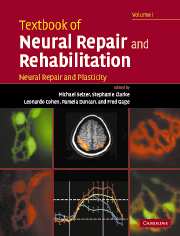Book contents
- Frontmatter
- Contents
- Contents (contents of Volume II)
- Preface
- Contributors (contributors of Volume I)
- Contributors (contributors of Volume II)
- Neural repair and rehabilitation: an introduction
- Section A Neural plasticity
- Section A1 Cellular and molecular mechanisms of neural plasticity
- Section A2 Functional plasticity in CNS system
- 6 Plasticity of mature and developing somatosensory systems
- 7 Activity-dependent plasticity in the intact spinal cord
- 8 Plasticity of cerebral motor functions: implications for repair and rehabilitation
- 9 Plasticity in visual connections: retinal ganglion cell axonal development and regeneration
- 10 Plasticity in auditory functions
- 11 Cross-modal plasticity in sensory systems
- 12 Attentional modulation of cortical plasticity
- Section A3 Plasticity after injury to the CNS
- Section B1 Neural repair
- Section B2 Determinants of regeneration in the injured nervous system
- Section B3 Promotion of regeneration in the injured nervous system
- Section B4 Translational research: application to human neural injury
- Index
12 - Attentional modulation of cortical plasticity
from Section A2 - Functional plasticity in CNS system
Published online by Cambridge University Press: 05 March 2012
- Frontmatter
- Contents
- Contents (contents of Volume II)
- Preface
- Contributors (contributors of Volume I)
- Contributors (contributors of Volume II)
- Neural repair and rehabilitation: an introduction
- Section A Neural plasticity
- Section A1 Cellular and molecular mechanisms of neural plasticity
- Section A2 Functional plasticity in CNS system
- 6 Plasticity of mature and developing somatosensory systems
- 7 Activity-dependent plasticity in the intact spinal cord
- 8 Plasticity of cerebral motor functions: implications for repair and rehabilitation
- 9 Plasticity in visual connections: retinal ganglion cell axonal development and regeneration
- 10 Plasticity in auditory functions
- 11 Cross-modal plasticity in sensory systems
- 12 Attentional modulation of cortical plasticity
- Section A3 Plasticity after injury to the CNS
- Section B1 Neural repair
- Section B2 Determinants of regeneration in the injured nervous system
- Section B3 Promotion of regeneration in the injured nervous system
- Section B4 Translational research: application to human neural injury
- Index
Summary
Introduction
Can willing make it so? (Pollack, 2004). Specifically, in the context of attention and plasticity, can the exercise of conscious selection (attention) make the brain change (cortical plasticity) and is it necessary for the brain to change? If so, a purposeful plan could be a useful tool in changing the brain by inducing cortical plasticity. Knowledge of how plasticity can be induced would, in turn, be invaluable in trying to fix a damaged brain or to optimize learning strategies in a normal brain. In order to understand if this is possible, we need to first understand the definition of attention, its behavioral implications, and its neural and pharmacological basis. We can then turn to whether attention can act as a gating mechanism for plasticity: is it necessary for plasticity to occur? Finally, do these phenomenon act on the same pathways: is attention a prelude to learning? When we begin to understand those questions, we can begin to address whether attention will be a useful tool to manipulate the changes in the brain that underlie learning and recovery from damage.
Attention in this article will refer to selective or focused attention, the conscious exercise of will to chose to select one option, sensory input, or output over others. Attention is most frequently studied in the visual domain, where attention is known to improve the processing of certain visual information at the expense of other information that is presented simultaneously.
Keywords
- Type
- Chapter
- Information
- Textbook of Neural Repair and Rehabilitation , pp. 194 - 206Publisher: Cambridge University PressPrint publication year: 2006
- 1
- Cited by



